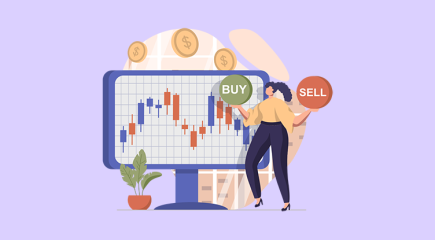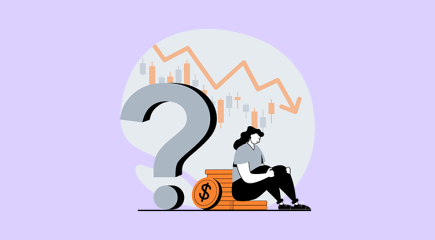A common mistake that many novice traders make is trading in a way that increases risk rather than reducing it. They justify this by thinking they are increasing their profit potential, but they are actually setting themselves up for failure.
This article will show you how to avoid this mistake, increase your profit potential, reduce risk, and set yourself up for long-term trading success.
Let’s look at the wrong way to trade by introducing a novice trader named Frank. Frank has a $100,000 investment portfolio and finds an undervalued stock. He believes the business is misunderstood, and the price chart is forming a bottom. He invests 4% of his portfolio, or $4,000, into the stock without an exit strategy, hoping for the best.
Initially, things go well for Frank. The stock rises 5%, then 10%, and he feels good about his decision. Unfortunately, the stock soon declines, and Frank finds himself down 20% on the trade, reducing his $4,000 investment to $3,200. Despite this, Frank is convinced that the stock will recover and invests another $4,000 when it drops further.
Frank’s idea doesn’t work out, and he ultimately cuts his losses after the stock falls another 20%, resulting in a loss of $2,240. Frank’s actions may seem crazy, but many traders make this mistake repeatedly. This strategy is known as “dollar cost averaging,” where traders buy more shares at a lower price, causing the average cost per share to drop. This approach can be useful, but should only be used if they’re not at their full investment from the start.
Instead of “dollar cost averaging,” you should consider “scaling in” to a trade. Scaling in involves starting with a smaller-than-normal position and building that position over time. One way to scale involves choosing a stop-loss and buying a small position.
For example, buying one-third of what you consider a “normal” position for speculation. If shares drop to your stop loss, you exit the trade with a slight loss and move on.
If shares rise and the trade still looks good, add an additional one-third position. Here you would tighten your stop loss. You do this to keep your potential loss on the combined position as small as possible and smaller than your original loss potential. In other words, you can simultaneously reduce your risk and increase your profit potential.
If shares continue rising, you can repeat the same process again. Buy more and tighten your stop. This approach reduces your risk while increasing your profit potential, setting you up for long-term success.
Let’s consider an example to illustrate this approach further. Suppose you find a cheap, misunderstood business called Bob’s Tech (XYZ) with a price chart that looks like it’s forming a bottom. You believe it has at least 100% upside potential, but you also know that Bob’s Tech has a volatile history.
In this case, you want to use a wide 33% stop loss, meaning you would buy a one-third position rather than a full one. Suppose you normally put $10,000 into a stock like this, so you start with $3,333 instead and buy 66 shares at $50.
After two weeks, Bob’s Tech is up 20%, and after a month that included a sharp drop and an even bigger rally, it is up 35%, trading at $67.50. Your position is now worth $4,455, and you decide to buy another one-third position while tightening your stop loss from 33% below your purchase price to 26% below the current $67.50 share price. This move increases your profit potential.
A few weeks later, the market takes a downturn, and Bob’s Tech’s share price drops to $55. This is below your average price of $57.45 but above your adjusted stop loss of $49.95.
At this point, you can do one of two things. You can hold on to your position and wait for Bob’s Tech’s price to rebound. Or, you can add another one-third position, tighten your stop loss again, and increase your profit potential even further.
Let’s say you add another one-third position at $49.95 per share. This time, you tighten your stop loss to 25% below the current share price, or $37.64. If the price drops to $37.64, you will exit the trade and take a slight loss.
With your new purchase of $3,333, you can buy 67 shares of Bob’s Tech at $49.95 per share. This brings your total investment to $10,000 and your total number of shares to 182.
A few weeks later, Bob’s Tech’s price rose to $68 per share. Your position is now worth $12,376, a 24% gain on your original investment of $10,000.
At this point, you can decide to sell your entire position for a profit, or you can continue to hold on to your shares and potentially make even more money if Bob’s Tech’s price continues to rise.
By scaling into the trade with Bob’s Tech, you were able to reduce your risk and increase your profit potential. Instead of putting your entire investment into the stock at once and potentially losing a significant amount of money if the trade went against you, you started with a smaller-than-normal position. You added to it as the trade moved in your favor.
You also tightened your stop loss as the trade moved in your favor, which helped to ensure that your potential losses remained small even as your potential gains increased.
This is just one example of how scaling into trade can help you increase your profit potential and reduce your risk. By starting with a more minor position and building it over time as the trade moves in your favor, you can give yourself a better chance of success in the markets.
Remember, the key is to have a plan in place before you enter a trade. This includes setting your stop loss and determining how much of your investment you will risk on the trade.
If you’re new to trading, working with a mentor or joining a community of traders who can offer guidance and support can be helpful. With the right mindset and approach, you can succeed in the markets and build a profitable trading career over time. Get started now by downloading our free trading course or stock trading books, taking the first steps to setting up your portfolio for success.







